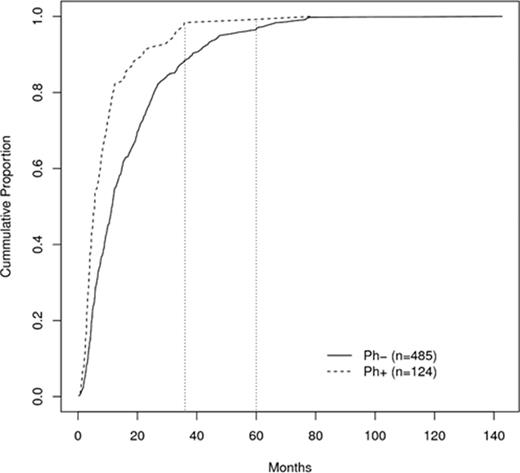Abstract

Background: Current chemotherapy regimens in children with ALL produce disease-free survival (DFS) rates of greater than 80%. In contrast, adults with ALL have a much poorer prognosis, with DFS rates of 30-40%. Recent prospective studies suggest that young adults may have superior outcomes when treated with intensive pediatric regimens. We recently reported a 4-yr DFS and overall survival (OS) of 69% (n=78 who achieved CR) and 67% (n=92), respectively (DeAngelo et al. Leukemia 2015) using a native E. coliasparaginase based regimen. This phase II successor trial was performed to determine if a pediatric regimen using pegylated-asparaginase (peg-asp) could be feasibly administered to adults.
Methods: Patients (pts) between 18-50 yrs with de novo ALL were eligible. The primary objective of this study was to determine the feasibility of a single dose of peg-asp during induction and of delivering peg-asp every 2 wks during a 30 wk consolidation period. The therapeutic backbone of this protocol was based on the very high-risk arm of the DFCI Childhood ALL Consortium Protocol 05-01. Pts received induction chemotherapy, which included doxorubicin, prednisone, vincristine, pegylated-asparaginase (peg-asp), and triple intrathecal therapy. Consolidation I consisted of a course of high-dose methotrexate, followed by a BFM-like intensification and a course of high-dose cytarabine, etoposide and dexamethasone. CNS prophylaxis included triple intrathecal therapy and cranial radiation. Intensification therapy consisted of eight 3-wk courses of doxorubicin, vincristine, dexamethasone, 6-mercaptopurine and 30 wks of IV peg-asp initially dosed at 2500 IU/m2every 2 wks. Continuation therapy consisted of 3 wk courses of vincristine, dexamethasone, methotrexate and 6-mercaptopurine for a total of 2 yrs from complete remission (CR). Imatinib at 600 mg/d was administered to those pts who were Philadelphia chromosome (Ph) positive.
Results: Of 112 pts enrolled, 110 were eligible. The first 65 pts were treated with the initial study design of IV peg-asp during induction and peg-asp every two wks for 15 doses during consolidation. However, due to the high frequency of asparaginase toxicities mainly hyperbilirubinemia, peg-asp was replaced with native E. coli asp at a dose of 25,000 IU/m2 IM during induction and the dose and frequency peg-asp was decreased to 2000 IU/m2 every 3 wks during the consolidation phase in the subsequent 45 pts. The median age was 32 yrs, (range, 18-50), 61% were male, 82% had B-lineage phenotype, and 21 were Ph positive. The CR rate after 4 wks was 89%. 70 pts had the opportunity to receive peg-asp intensification therapy (42 at the 2500 IU/m2 every 2 wks schedule and 28 on the 2000 IU/m2 every 3 wk schedule). Of the 42, 18 pts (43%; 80% CI, 32-54%) on the 2 wk schedule completed at least 13 of 15 doses of peg-asp (26 wks) and 22 of 28 pts (79%; 80% CI, 65-88%) on the 3 wk schedule completed at least 8 of 10 doses of peg-asp, which met the feasibility endpoint (lower bound CI > 60%). The median asp levels post the induction dose of peg-asp were 0.025, 0.78, 0.28, 0.10, at baseline, 7, 11 and 25 days and >0.20 for each consolidation time point for both the 2 and 3 wk cohorts. Two deaths occurred during induction therapy (sepsis; CNS hemorrhage). Post-induction four pts developed pancreatitis, 14 pts had an allergic reaction to the asp, 12 pts developed osteonecrosis, 2 had a bone fracture, 13 pts had thrombosis/embolism and 32 pts had a grade 3-4 neutropenic infection. With a median follow-up time of 39 mos, the estimated 3-yr DFS is 73% for those who achieved a CR (n=90) and the estimated 3-yr OS is 75%.
Conclusions: The administration of a dose intensified pediatric regimen with peg-asp to adults with ALL is feasible. However, the dose and schedule of peg-asp that is well-tolerated in adults is lower and less frequent as compared to that of pediatric pts. Although the DFS and OS are high for an adult cohort, longer follow up is needed. Pediatric-like therapies, including those using intensive peg-asp, are tolerable in young adults with ALL and represent a major therapeutic advance.
Outcome Summary
| . | n . | 3-yr % OS [95% CI] . | n . | 3-yr % DFS [95% CI] . |
|---|---|---|---|---|
| All Pts./CR Pts. | 110 | 75 [66-82] | 90 | 73 [62-81] |
| Immunophenotype | ||||
| B cell | 90 | 74 [64-82] | 72 | 70 [58-80] |
| T cell | 20 | 78 [52-91] | 18 | 83 [57-94] |
| Ph- | 89 | 80 [70-87] | 78 | 75 [63-84] |
| . | n . | 3-yr % OS [95% CI] . | n . | 3-yr % DFS [95% CI] . |
|---|---|---|---|---|
| All Pts./CR Pts. | 110 | 75 [66-82] | 90 | 73 [62-81] |
| Immunophenotype | ||||
| B cell | 90 | 74 [64-82] | 72 | 70 [58-80] |
| T cell | 20 | 78 [52-91] | 18 | 83 [57-94] |
| Ph- | 89 | 80 [70-87] | 78 | 75 [63-84] |
DeAngelo:Pfizer: Consultancy; Amgen: Consultancy; Incyte: Consultancy; Bristol Myers Squibb: Consultancy; Agios: Consultancy; Ariad: Consultancy; Novartis: Consultancy; Celgene: Consultancy. Storring:Celgene Canada: Honoraria, Membership on an entity's Board of Directors or advisory committees; Novartis Canada: Honoraria, Membership on an entity's Board of Directors or advisory committees. Steensma:Celgene: Consultancy; Amgen: Consultancy; Incyte: Consultancy; Onconova: Consultancy. Stone:Pfizer: Consultancy; Juno: Consultancy; AROG: Consultancy; Amgen: Consultancy; Agios: Consultancy; Celator: Consultancy; Novartis: Research Funding; Sunesis: Consultancy, Other: DSMB for clinical trial; Abbvie: Consultancy; Karyopharm: Consultancy; Celgene: Consultancy; Merck: Consultancy; Roche/Genetech: Consultancy.
Author notes
Asterisk with author names denotes non-ASH members.

This icon denotes a clinically relevant abstract


This feature is available to Subscribers Only
Sign In or Create an Account Close Modal